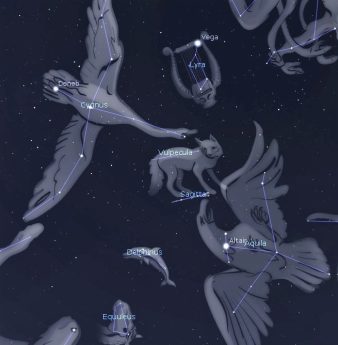This Week’s Sky at a Glance, 2024 July 20 – July 27
This Week’s Sky at a Glance, 2024 July 20 – July 27
They say it is the little things that count, and if you are counting constellations there are four little ones lined up in the southeast toward late evening. Start your search with the Summer Triangle, which is composed of the brightest star in each of three constellations: Vega in Lyra the Lyre, Deneb in Cygnus the Swan, and Altair in Aquila the Eagle. Sagitta the Arrow is a distinct shape between Altair and Albireo, which is at the head of Cygnus. The arrow, poisoned with the blood of the Hydra, is one of those shot by Hercules to kill the Stymphalian birds as his sixth Labour.
Between Sagitta and Albireo is obscure Vulpecula the Fox, which at one time was two constellations called the Little Fox and the Goose. Vulpecula is known best for having the binocular object M27, the Dumbbell Nebula, within its borders. Below Sagitta is the eye-catching Delphinus the Dolphin, seen leaping out of the watery constellations that hug the horizon below. The dolphin was given its place of honour in the sky by Poseidon for convincing beautiful Amphitrite to be his wife. Below Delphinus and just off the snout of Pegasus the Flying Horse is Equuleus the Little Horse, the second smallest of the 88 constellations. Perhaps representing the foal Celeris, an offspring or brother of Pegasus, it was one of the 48 constellations included in Claudius Ptolemy’s second-century map of the sky.
This Week in the Solar System
Saturday’s sunrise in Moncton is at 5:48 and sunset will occur at 9:02, giving 15 hours, 14 minutes of daylight (5:56 and 9:04 in Saint John). Next Saturday the Sun will rise at 5:56 and set at 8:54, giving 14 hours, 58 minutes of daylight (6:03 and 8:57 in Saint John).
The Moon is full this Sunday, rising near Saturn late Wednesday and reaching third quarter just before midnight next Saturday. By midweek Venus sets 45 minutes after sunset, followed by Mercury 20 minutes later. Mercury is dimming and becoming more difficult to see with binoculars, but it is still brighter than Regulus half a binocular field above it. Over the week Mars slides between the Hyades and Pleiades star clusters, with bright Jupiter to their left.
On Sunday evening at 8 pm tune in to the Sunday Night Astronomy Show via the Facebook page or YouTube channel of Astronomy by the Bay.
Weekly Sky at a Glance ~by Curt Nason

